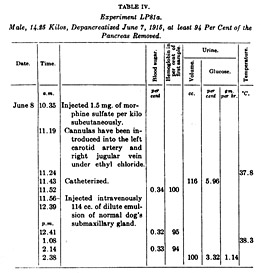Prelude to the Discovery of Insulin: Proving that a Pancreatic Substance Lowers Blood Sugar in Diabetes

Kleiner, Israel
Courtesy of the Rockefeller Archive Center
At the turn of the twentieth century, scientists knew that the pancreas played a role in regulating levels of sugar in the blood and urine in diabetes, but they debated several competing theories about the origin of the disease. Between 1915 and 1919, Israel Kleiner (1885-1966) carried out a series of experiments at Rockefeller proving definitively that a substance from the pancreas lowered blood sugar, and he suggested that the effective agent might be isolated and used therapeutically. Although the significance of Kleiner's finding was well-recognized within the scientific community, his work was overshadowed by the purification of insulin and its introduction into clinical use in 1921-1922 by researchers at the University of Toronto. In 1923, two of these men, Frederick Banting and John Macleod, shared the Nobel Prize.
German researchers had found in 1889 that removing the pancreas from a dog induced the symptoms of diabetes. For decades afterward, this was the animal model used by physiologists studying diabetes, including Kleiner, who worked under Samuel Meltzer. When Kleiner injected a dextrose solution into the blood of depancreatized dogs, he found-as expected-that blood sugar rose and remained high, and that sugar was excreted in the urine. But when he added a pancreatic emulsion to the dextrose solution, blood sugar levels responded as in normal dogs, returning to baseline by 90 minutes after injection. Other researchers had attempted similar studies, but Kleiner's were the most rigorous. He took blood sugar readings both before and after giving the sugar solution, and his pancreatic emulsion was made only with saline solution-it had no ingredients that could have affected the blood sugar measurements. He also tested whether infusing other ground-up tissues affected blood sugar (they did not). At a festschrift on the occasion of Kleiner's 70th birthday, the eminent clinical chemist Donald D. Van Slyke recalled Kleiner's work at Rockefeller and stated that, "the next steps, in separating insulin from the extract and applying it to treatment of diabetes, were inevitable."

The action of intravenous injections of pancreas emulsions in experimental diabetes. From J Biol Chem, 1919, 40: 153-170
Israel S. Kleiner received the PhD from Yale University (1909). He joined the laboratory of Samuel J. Meltzer at the Rockefeller Institute the next year. In 1919 he was appointed professor at the New York Homeopathic Medical College (later called New York Medical College), and served as dean from 1921 to 1925. He remained there for the rest of his career, becoming professor of biochemistry in 1935 and director of the department of biochemistry in 1948. Kleiner received the Van Slyke Award in Clinical Chemistry (1959) and the New York Medical College Medal of Honor (1959). He was the author of two well-regarded textbooks: Human Biochemistry (C.V. Mosby, 1945) and Laboratory Instructions in Biochemistry (C.V. Mosby).
Selected Publications
Kleiner IS and Meltzer SJ. Retention in the circulation of dextrose in normal and depancreatized animals, and the effect of an intravenous injection of an emulsion of pancreas upon this retention. Proc Natl Acad Sci USA, 1915, 1: 338-342
http://www.pnas.org/content/1/6/338.full.pdf+html
Kleiner IS. The action of intravenous injections of pancreas emulsions in experimental diabetes. J Biol Chem, 1919, 40: 153-170
http://www.jbc.org/cgi/reprint/40/1/153
Further Reading
Bliss M. The Discovery of Insulin: Twenty-fifth Anniversary Edition. Chicago: Univ Chicago Press, 2007
Meltzer A. Breath of Life: The LIfe and Works of Dr. Samuel James Meltzer. New York: Vantage Press, 1993, pp 225-227
Mering von J, Minkowski O. Diabetes mellitus nach Pankreasextirpation. Archiv Exp Pathol Pharmacol, 1890, 26: 371
Links
Barthold SW. Introduction: Unsung heroes in the battle against diabetes. ILAR Journal, 2004, 45: 227-230
http://dels.nas.edu/ilar_n/ilarjournal/45_3/html/index.shtml
